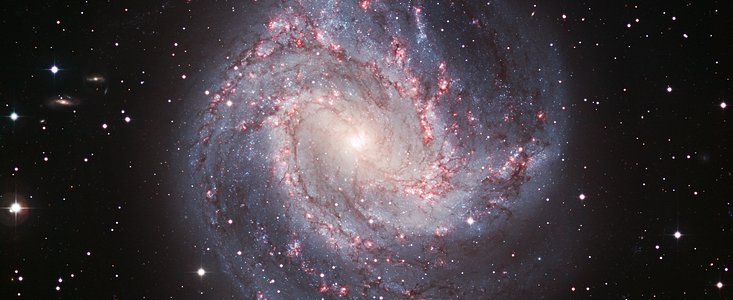Press Release
The Thousand-Ruby Galaxy
A prodigious pinwheel shines in the darkness
2 September 2008
ESO's Wide Field Imager has captured the intricate swirls of the spiral galaxy Messier 83, a smaller look-alike of our own Milky Way. Shining with the light of billions of stars and the ruby red glow of hydrogen gas, it is a beautiful example of a barred spiral galaxy, whose shape has led to it being nicknamed the Southern Pinwheel.
This dramatic image of the galaxy Messier 83 was captured by the Wide Field Imager at ESO's La Silla Observatory, located high in the dry desert mountains of the Chilean Atacama Desert. Messier 83 lies roughly 15 million light-years away towards the huge southern constellation of Hydra (the sea serpent). It stretches over 40 000 light-years, making it roughly 2.5 times smaller than our own Milky Way. However, in some respects, Messier 83 is quite similar to our own galaxy. Both the Milky Way and Messier 83 possess a bar across their galactic nucleus, the dense spherical conglomeration of stars seen at the centre of the galaxies.
This very detailed image shows the spiral arms of Messier 83 adorned by countless bright flourishes of ruby red light. These are in fact huge clouds of glowing hydrogen gas. Ultraviolet radiation from newly born, massive stars is ionising the gas in these clouds, causing the great regions of hydrogen to glow red. These star forming regions are contrasted dramatically in this image against the ethereal glow of older yellow stars near the galaxy's central hub. The image also shows the delicate tracery of dark and winding dust streams weaving throughout the arms of the galaxy.
Messier 83 was discovered by the French astronomer Nicolas Louis de Lacaille in the mid 18th century. Decades later it was listed in the famous catalogue of deep sky objects compiled by another French astronomer and famous comet hunter, Charles Messier. Recent observations of this enigmatic galaxy in ultraviolet light and radio waves have shown that even its outer desolate regions (farther out than those seen in this image) are populated with baby stars. X-ray observations of the heart of Messier 83 have shown that its centre is a hive of vigorous star formation, held deep within a cloud of superheated gas, with temperatures of 7 million degrees Celsius. Messier 83 is also one of the most prolific producers of supernovae, that is, exploding stars: this is one of the two galaxies, which had 6 supernovae in the past 100 years. One of these, SN 1957D was observable for 30 years!
The Wide Field Imager (WFI) is a specialised astronomical camera attached to the 2.2-metre Max-Planck Society/ESO telescope, sited at the La Silla observatory in Chile. Located nearly 2400 m above sea level, atop the mountains of the Atacama Desert, ESO's La Silla enjoys some of the clearest and darkest skies on the whole planet, making the site ideally suited for studying the farthest depths of the Universe.
To make this image, the WFI stared at M83 for roughly 100 minutes through a series of specialist filters, allowing the faint detail of the galaxy to reveal itself. The brighter stars in the foreground are stars in our own galaxy, whilst behind M83 the darkness is peppered with the faint smudges of distant galaxies.
Contacts
Henri Boffin
ESO
Garching, Germany
Tel: +49 89 3200 6222
Email: hboffin@eso.org
Valentina Rodrigue
ESO
Chile
Tel: +56 2 463 3123
Email: vrodrigu@eso.org
About the Release
| Release No.: | eso0825 |
| Legacy ID: | PR 25/08 |
| Name: | Messier 83, Southern Pinwheel Galaxy |
| Type: | Local Universe : Galaxy : Type : Spiral |
| Facility: | MPG/ESO 2.2-metre telescope |
| Instruments: | WFI |

